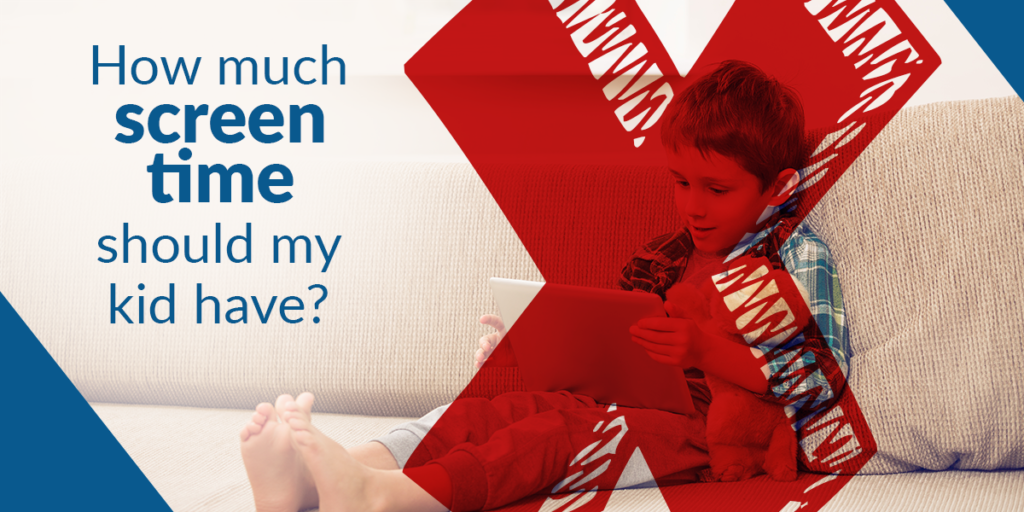Is there a safe amount of screen time for my kids? How much is okay? What about the use of technology at school? Do they need special eyewear when they’re using digital devices?
To answer these questions, let’s take a look at what we know about digital devices and how they’re used today.
Over 70% of American families report their kids are getting more than two hours of screen time every single day. Besides playing outside, playing on a digital device and watching tv are reported as kids’ top activities these days.
Of course, kids aren’t just using devices at home. They’re also using them at school. Do you remember back in the day when we all learned off of black and green chalkboards? Today, old-fashioned chalkboards have been replaced by shiny whiteboards — the dry-erase kind, and the digital kind.
While this advent of technology helps teachers and kids learn in new, interactive ways, it can also take a toll on young eyes.
After being exposed to two or more hours of screen time, parents report their children experience the following:
- Headaches
- Neck/shoulder pain
- Eye strain, dry or irritated eyes
- Reduced attention span
- Poor behavior
- Irritability
Why do our devices have these effects, and what can we do about it?
BLUE LIGHT
The full spectrum of visible light that we see is red, orange, yellow, green, blue, indigo, and violet.
The light emitted by digital devices like laptops, tablets, smartphones and modern TVs is blue.
Unfortunately, Blue Light happens to be the light that suppresses the production of melatonin, the sleep-promoting hormone.
That’s why experts like Dr. Charles Czeisler, chief of the Division of Sleep and Circadian Disorders at Brigham and Women’s Hospital in Boston, believe it’s best to avoid staring at computer screens, iPads and smartphones two or three hours before bedtime.
What can we do to curb some of these negative effects?
LIMIT SCREEN TIME
When it comes to kids, setting healthy boundaries and limiting their time on devices (especially in the evening), is the first step.
Here are a few ways to limit screen time:
- Model healthy electronic use: as a parent, show your kids how to have healthy habits. That means turning the tv off and not scrolling through your social media feed all the time.
- Create technology-free zones around the house: many families have a no-technology rule at dinner times, for instance. This means no phones or tablets at the table, so families can sit down and enjoy each other’s company.
- Keep digital devices out of bedrooms: we know devices can be addictive, and we know they can interfere with sleep. That’s why keeping phones, computers, and TVs out of the bedroom is so important.
- Talk to your kids about the dangers! One of the best and most proactive things we can do as parents is to educate our kids (and ourselves), on the dangers of digital devices (when over-used). Help your kids understand why it’s not healthy to be constantly plugged in so they can practice making their own wise decisions.
A part of setting healthy limits includes teaching kids to take breaks to minimize eye strain and give their brain a break, too. Encourage your kids to do activities that get them moving, like playing, going outside, socializing — and just being kids! For more tips on how to minimize eye strain — like the 20-20-20 rule — read our blog on Relieving Computer Eye Strain.
USE BLUE BLOCKERS
Due to our increasing reliance on digital devices for school, work, and entertainment, it’s not always possible to set time limits that work.
That’s where blue blockers come into place.
Blue blockers are eyewear that, as the name implies, block some or all Blue Light.
This can help protects kids’ ability to sleep well if they’re required to spend time on the computer before bed.
A small 2014 study of Swiss teen boys (published in the Journal of Adolescent Health) found a significant difference between the teens wearing blue blockers than those wearing clear lenses. The group that wore blue blockers while working on the computer a few hours before bedtime were significantly more sleepy than the group who wore only clear lenses.
If you and your kids already have prescription eyewear, you can get lenses that have Blue Light-filtering capabilities. Make sure to talk to your eye care provider to learn about your options.
Don’t wear glasses or contact lenses? That’s okay! You can also get non-prescription blue blocker lenses. Ask your eye care provider for recommendations for a reputable brand.
While we can’t always remove the digital devices from our kids’ lives, the most important thing we can do as parents is set healthy limits, teach smart habits, get kids outside, and get simple eyewear that helps.
Talk to your optometrist to learn more about Blue Light-blocking technology.
Sources:
- http://www.thevisioncouncil.org/content/digital-eye-strain
- https://www.consumerreports.org/eyeglass-stores/3-blue-blockers-put-to-the-test/
- https://www.verywellfamily.com/tips-for-limiting-electronics-and-screen-time-for-kids-1094870

[formlift id=”804″]

